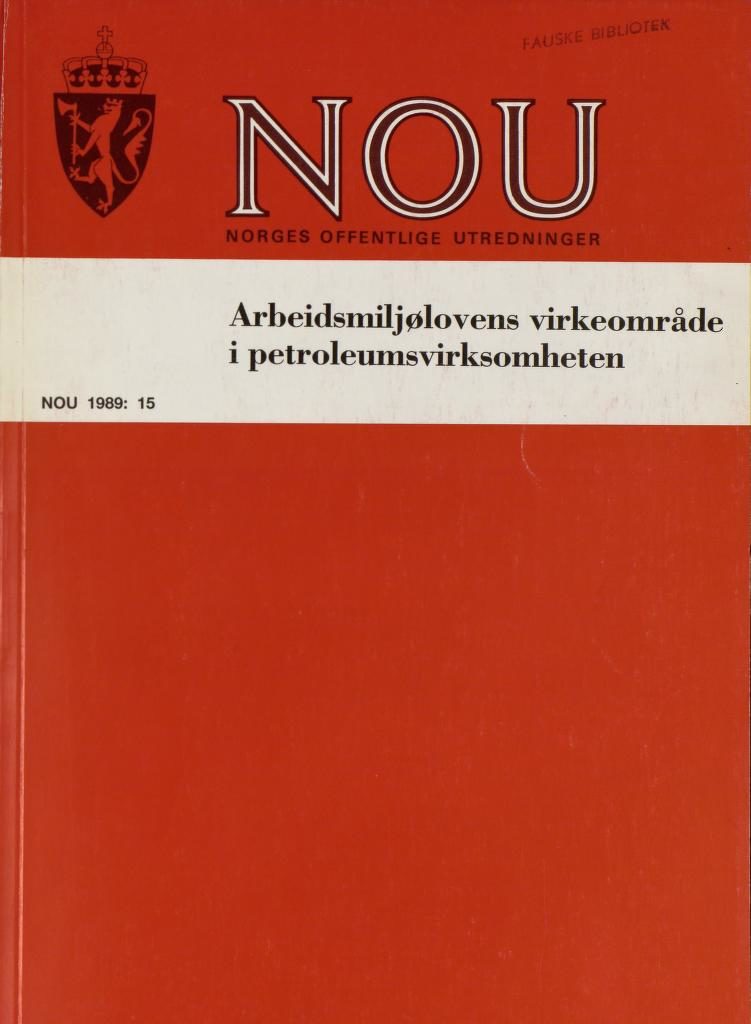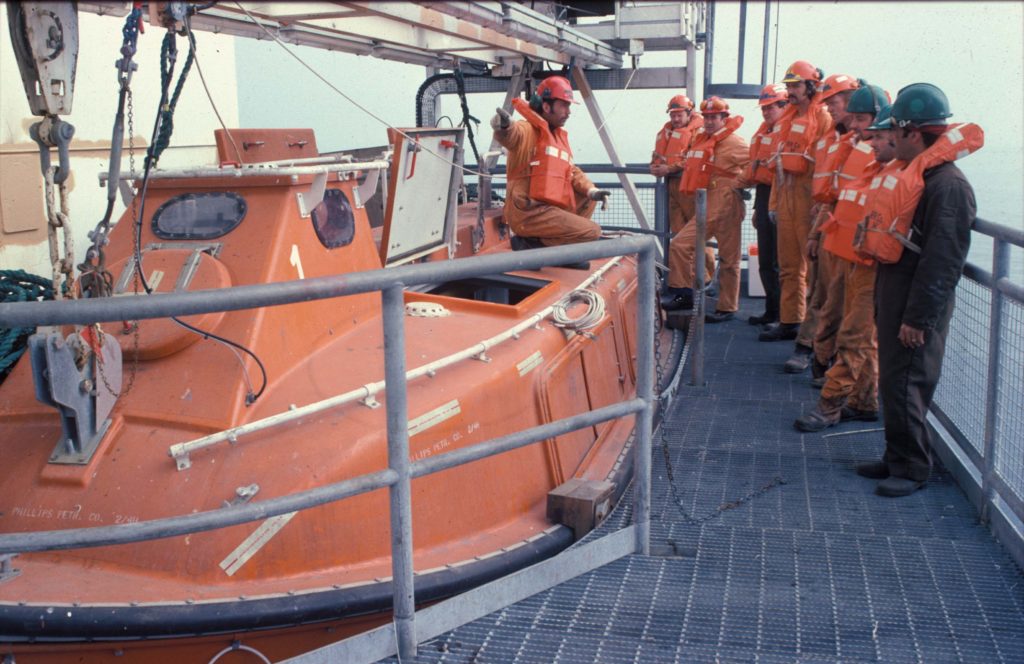Working Environment Act

The initiative for the WEA was taken in 1973 by the Labour government headed by Trygve Bratteli. But it was by no means clear that it would be extended to cover oil industry workers.
Both the Norwegian Petroleum Directorate (NPD) and the Ministry of Industry – then responsible for petroleum issues – maintained that the offshore sector’s special character should qualify it for exemption from the Act.
Working time in particular became a matter of dispute. The NPD claimed that reducing this offshore would be impossible in practice, and wanted it excluded from the Act.
In the summer of 1975, however, a restructuring of working hours for operations personnel on Ekofisk by operator Phillips removed the basis for the NPD and ministry objections.
 Arbeidsmiljølovens virkeområde i petroleumsvirksomheten. NOU 1989: 15
Arbeidsmiljølovens virkeområde i petroleumsvirksomheten. NOU 1989: 15The WEA represented a radical reform. Working environment issues were to be dealt with as far as possible locally, between employees and employers.
That contrasted with the earlier Norwegian regime for worker health and safety, where the emphasis had been on inspections and official orders.
The Act also addressed the working environment as a whole. It introduced requirements that every job should contain vocational challenges and variation. Monotonous work was to be avoided.
Establishing the safety delegate system represented the WEA’s most important instrument for enhancing worker participation (also known as industrial democracy).
Company management was legally required to collaborate with a safety delegate elected by the workforce, but the role of these delegates was also controversial.
Particular objections were raised about their power to halt a specific job which they felt involved substantial risk. It was argued that such stoppages could pose an even bigger threat in certain cases.
When the draft WEA was presented in August 1975, extending it to the NCS was also recommended. A committee would be appointed to assess certain exemptions.
That did not happen immediately, but an incident then occurred which demonstrated the seriousness of the safety position in the offshore sector.
On 1 November 1975, a fire broke out on the Ekofisk 2/4 A (Alpha) platform. Three men died – not from the blaze, but from inaccurate use of safety equipment.
That gave extra urgency to work on the WEA. A committee chaired by Kåre Halden, director general of the Ministry of Labour and Local Government, was appointed to assess exemptions from some provisions in the Act.
Government agencies, the Norwegian Confederation of Trade Unions (LO), the Norwegian Employers Federation (NAF) and Norway’s shipowners were represented on this body.
However, the North Sea Operator’s Committee for the employers and the Ekofisk Committee union were excluded. The latter, which organised most workers on Ekofisk, reacted particularly strongly.
In February 1976, it was decided that the Ekofisk Committee would nevertheless be allowed a representative on the inquiry. But Phillips as operator continued to be excluded.
The decision was taken on 9 July 1976 that the existing Worker Protection Act, with some exceptions, would be temporarily extended to fixed North Sea installations.
These exemptions related primarily to the Act’s working time provisions. Instead, separate sections were introduced to set limits on hours worked.
Finally, on 24 July 1977, the WEA was extended to the NCS with the Halden committee’s exemptions and clarifications. It would be administered by the NPD.
The Act was not applied to mobile facilities. These continued to be covered by the Ship Labour Act, with compliance monitored by the Norwegian Maritime Directorate.[REMOVE]Fotnote: Smith-Solbakken, Marie and Ryggvik, Helge, Blod, svette og olje. Norsk oljehistorie, volume 3, Oslo, 1997. Nor did the NEA cover diving until 1992.
Regulating offshore safety
On 22 May 1970, the Norwegian government appointed a commission to submit proposals on safety regulations for production facilities, pipelines, seabed storage installations and exploitation of petroleum deposits.
The Ekofisk discovery had meant that a number of political issues had to be clarified, legislation for the petroleum sector put in place and institutions built up.
While the safety issue was not forgotten at this time, it was pushed a little to one side. However, some formal protection for oil workers was provided by the 1967 drilling regulations.
During the development phase on Ekofisk, safety was protected first and foremost through the conditions imposed on Phillips by the industry ministry.
The official commission mentioned above worked slowly, and little happened before NPD department head Nils Vogt the took over the chair.
He presented the commission’s recommendations on 12 June 1975, and these proposals were largely adopted for fixed installations on the NCS by royal decree of 9 July 1976.
In other words, it took six years to put Norway’s offshore safety regulations in place. They related almost entirely to technical aspects, and formal regulations for platform workers were not adopted until the WEA became applicable in 1977.
Disaster spurs new safety regime
The Alexander L Kielland disaster in 1980, when this accommodation rig turned turtle, had direct consequences for NCS safety. Their most visible manifestation was mandatory use of survival suits, but other measures were also implemented.
A number of irregularities were identified by the inquiry into the accident, including employee training. The 1976 safety regulations had established the liability of licensees the ensure that this was adequate.
This requirement had been reinforced with the introduction of the WEA, and personnel were obliged to undergo a three-week safety training course.
However, only 76 of the 212 people on Alexander L Kielland when it overturned turned out to have received had any form of safety training. And 50 of these had only taken a one-day course.
Responses to the disaster included a requirement that all mobile facilities on the NCS had to return to land and be checked for cracks.
At the same time, all rigs had to possess sufficient buoyancy to stay afloat even after the loss of a support column (the lack of such buoyancy was why the Kielland had foundered).
The Norwegian Maritime Directorate issued orders in the autumn of 1980 that everyone on a mobile unit should be equipped with a survival suit. That also applied to fixed installations.
In addition, wearing survival suits and lifejackets became mandatory for all helicopter passengers while flying over the open sea.
New regulations also specified that the capacity of lifeboats and liferafts had to be increased, and their launch arrangements and accessibility improved.
Loose equipment had to be secured so that it could cope with listing up to 40 degrees, and requirements for safety training were further specified and tightened. Exemptions from such training were to be difficult to secure.[REMOVE]Fotnote: Smith-Solbakken, Marie and Ryggvik, Helge, Blod, svette og olje. Norsk oljehistorie, volume 3, Oslo, 1997.
 Kapasiteten til livbåter og redningsflåter skulle økes og sikkerhetskurs ytterligere konkretiseres og skjerpes. Foto: ConocoPhillips
Kapasiteten til livbåter og redningsflåter skulle økes og sikkerhetskurs ytterligere konkretiseres og skjerpes. Foto: ConocoPhillips